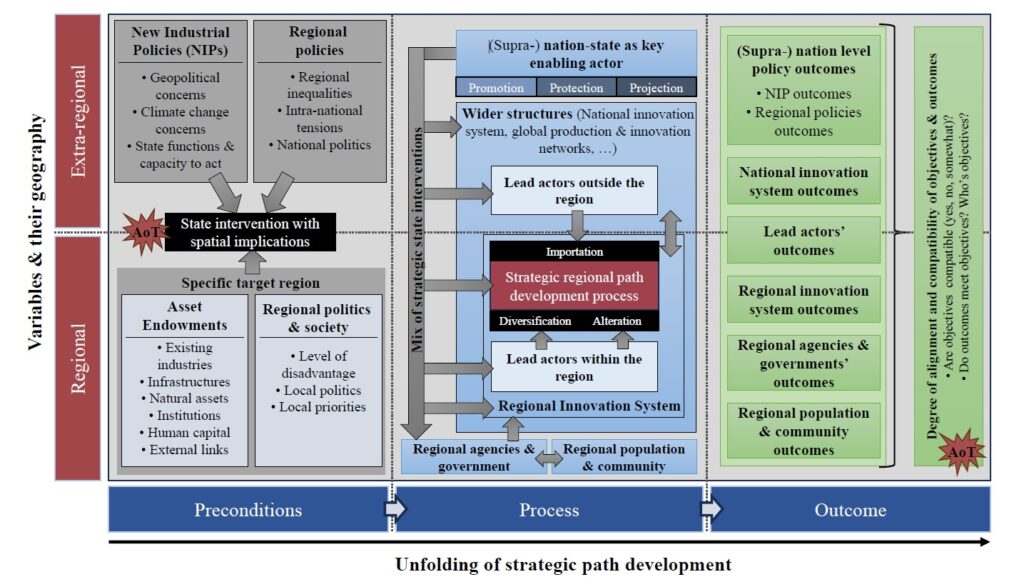Industrial Policy Meets Regional Development: The Geography of Strategic Industrial Ambitions

DOI reference: 10.1080/13673882.2025.12533892
By Simon Baumgartinger-Seiringer (e-mail), Center for Innovation Systems & Policy, Austrian Institute of Technology (AIT), Vienna, Austria and Chair in Innovation and Regional Development, HEC Montréal, Montreal, QC, Canada, Richard Shearmur, School of Urban Planning, McGill University, Montreal, QC, Canada, David Doloreux, Chair in Innovation and Regional Development, HEC Montréal, Montreal, QC, Canada and Amélie Gauthier, Department of International Business, HEC Montréal, Montreal, QC, Canada
Reference to the original article published in Regional Studies:
Baumgartinger-Seiringer, S., Shearmur, R., Doloreux, D., & Gauthier, A. (2025). Strategic regional path development: industrial policy, place and the rhetoric of regionalisation. Regional Studies, 59(1). https://doi.org/10.1080/00343404.2025.2529935
Industrial Policy is Back
Across the globe, governments are seeking to reshore production in strategic sectors – from semiconductors to clean energy – driven by geopolitical tensions, supply chain disruptions, and concerns over technological sovereignty. Importantly, these ambitions – in a very literal sense – take place. They unfold in specific regions, where the grand objectives of sovereignty, competitiveness, and resilience meet the realities of local assets, institutions, and communities.
The return of industrial policy is evident – inter alia – in the United States’ CHIPS and Science Act, in Europe’s efforts to integrate green industrial policy with “open strategic autonomy,” and in Canada’s and Québec’s investments in semiconductors. But while some of these initiatives speak the language of regional development, our research shows that regional development is sometimes less the goal than a useful narrative – instrumental in aligning actors, symbolic in legitimizing action, and often secondary in actual priority.
A New Concept: Strategic Regional Path Development
In our recent article, we introduce the concept of Strategic Regional Path Development (SRPD) to understand better how national and supranational industrial strategies are territorially realised. SRPD provides a lens to analyze how deliberate state interventions – from subsidies to export controls – aim to build industrial capacity and materialize technological sovereignty in particular places. It also helps us see the tensions and contradictions that arise when these top-down strategies meet the diverse expectations of regional actors.
Our framework (see Figure) traces SRPD through three dimensions on different geographical levels: preconditions, processes, and outcomes. Preconditions refer to the political realities and structural assets that make a region an attractive candidate for strategic investment. Processes describe how targeted interventions unfold, often propelled by the state but mediated through coalitions of firms, research organisations, and local authorities. Outcomes, finally, capture the effects of these interventions, which may strengthen sovereignty and industrial capacity but may raise questions about distributional impacts, regional equity, and long-term developmental consequences.

Methodology in Brief
We conducted an in-depth case study of the Technum Québec Innovation Zone (TQIZ) in Bromont, Canada. Our analysis is based on 31 interviews with policymakers, firms, research institutes, and municipal actors, complemented by government strategies, industry reports, and press articles. This combination allowed us to capture both official policy objectives and the local realities of implementation.
Case Study: Bromont and the Semiconductor Race
Bromont, a small city of around 12,000 inhabitants in southern Québec, may seem like an unlikely epicenter of global semiconductor ambitions. Yet it is home to IBM’s largest semiconductor assembly and testing facility worldwide, the MiQro Innovation Collaboration Center (C2MI), and several specialised firms. Its location between Montréal and Sherbrooke, with direct connections to Albany’s (USA) semiconductor hub, and even its clean air – which makes testing chips easier – create favourable preconditions.
When global supply chains faltered during the pandemic and other states poured billions into semiconductor subsidies, both the Canadian and Québec governments identified Bromont as the right place to strengthen sovereignty in this strategic sector. The result was significant federal investment through the Strategic Innovation Fund. These commitments, in turn, have also unlocked substantial private investments, with major firms expanding their activities in Bromont in collaboration with public partners.
At first sight, this may suggest a policy success with local benefits. Yet the case of SRPD in Bromont does not stand up to detailed scrutiny from a regional development perspective. The dominant drivers are industrial and geopolitical in nature, while place-based arguments are mobilised more as legitimising narrative than as substantive objective. Indeed, the promise of broader development outcomes is part of the discourse, but for many actors it remains uncertain whether the zone will really generate regional benefits. One interviewee put it succinctly:
“We have been here 50 years. … Despite the presence of two major firms and of C2MI, one can’t say that we have developed a flourishing zone. So … if, say, in the next five years we really, really, attain a new level of development, then it will prove that the zone really did it. Because ‘nature’ didn’t manage it alone over 50 years..”
Regional Outcomes and Narratives
As such, the case of Bromont shows both promise and tension. On the one hand, new investments may strengthen Canada’s position in global semiconductor supply chains, expand research capacity, and may attract additional start-ups. On the other hand, they also bring challenges. Bromont is already a relatively prosperous community, and the influx of new investments adds pressure to an area that faces acute labour and housing shortages and strained infrastructure. Surrounding municipalities risk carrying many of the costs without sharing in the additional tax revenues.
A closer look reveals that regional development serves as a powerful narrative. Policymakers invoke it to legitimise industrial policy, even if the concrete objectives remain geopolitical and industrial. Local actors can buy into this narrative because they stand to benefit, but many remain cautious. The rhetoric of development thus operates as a federating story – bringing together actors who otherwise pursue very different agendas.
Policy Implications
What does this tell us about the new geography of industrial ambitions? First, it highlights the need to align industrial and regional objectives early. Without such alignment, SRPD may exacerbate spatial inequalities rather than reduce them. Second, it reminds us that relying on a handful of global firms does not guarantee local spillovers. Broader participation, capacity-building, and genuine community involvement are crucial to ensure that industrial policy translates into long-term development. Finally, the case illustrates the risks of subsidy races and geopolitical escalation, which may create fragile development trajectories dependent on continuous state support and potentially delay sustainability transitions (Edler et al., 2023; Trippl et al., 2024).
Conclusion
The concept of Strategic Regional Path Development helps us understand how today’s industrial policies unfold in place. Bromont illustrates both the opportunities and pitfalls: a small town thrust into the global semiconductor race, mobilised to serve national sovereignty ambitions, and narrated as a regional development success. Industrial policy always takes place somewhere, and the politics of place matter. Narratives of regional development can align actors, but unless they are matched with meaningful coordination and local engagement, the long-term regional benefits of strategic industrial ambitions remain uncertain.
References
Bailey, D., Pitelis, C., & Tomlinson, P. R. (2023). Place-based industrial and regional strategy – Levelling the playing field. Regional Studies, 57(6), 977–983. https://doi.org/10.1093/cjres/rsz006
Edler, J., Blind, K., Kroll, H., & Schubert, T. (2023). Technology sovereignty as an emerging frame for innovation policy: Defining rationales, ends, and means. Research Policy, 52(6), 104765. https://doi.org/10.1016/j.respol.2023.104765
Gansauer, G. (2025). For growth or equity: A taxonomy of ‘Bidenomics’ place-based policies and implications for US regional inequality. Regional Studies, 59(1), 2399802. https://doi.org/10.1080/00343404.2024.2399802
Trippl, M., Soete, L., Kivimaa, P., Schwaag Serger, S., Koundouri, P., & Pontikakis, D. (2024). Addressing the regional dimension of open strategic autonomy and European green industrial policy. Publications Office of the European Union. https://doi.org/10.2760/141776